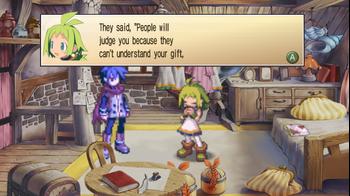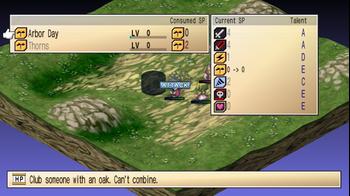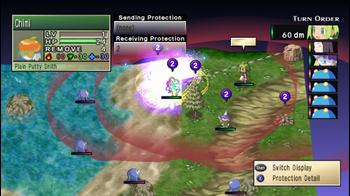Phantom Brave PC Review
Hot on the heels of the release of Disgaea PC, NIS America brings us another PS2-era strategy RPG to Steam. This time we get Phantom Brave, complete with all the extra content from the game’s remakes on Wii and PSP. NISA is billing Phantom Brave PC as the definitive version of this SRPG from the company’s ‘golden age’, but is it worth the purchase all these years later?
Phantom Brave focuses on the story of Marona, a young girl with the powers to commune with Phantoms, which are essentially the spirits of the dead. Her powers (known in the game world as Chromas) carry a negative stigma, and as such, she lives on an island alone in isolation, taking odd jobs to make ends meet. Although, ‘alone’ may not be the right term for it. Marona has a guardian - the phantom Ash - a friend of Marona’s deceased parents tasked with caring for the girl.
Unlike the typical Disgaea storyline, Phantom Brave is more on the serious and emotional side than humorous, and it works to the game’s advantage. Marona is a cheerful character, in spite of all the misguided hatred towards her—she prefers to be patient and optimistic to a fault, while Ash is a bit more down to earth and realistic about the world and how Marona is treated in it. Marona and Ash, along with the other characters, make for a compelling narrative, and is overall a good tale with a satisfying, if expected, conclusion.
In addition to the main story, there is also the additional ‘Another Marona’ story, from the Wii and PSP remakes. It takes place after the main story, and essentially everyone in the world save for Marona is killed, and it’s up to her and the sudden surge of Phantoms to defeat the threat from 30 years past that has returned. It’s a nice addition, since you get to try new characters with special abilities, and a fair amount of additional gameplay if you enjoyed that aspect as well.
Gameplay wise, Phantom Brave is an SRPG. However, there are some key differences that make it stand out from the average chessboard SRPG that most are familiar with. First off, instead of squares to move along, characters instead have a movement ‘ring’ that they can move in. This allows a far freer range of movement, and also changes skills to have more liberal areas of effect to compensate for the less rigid movement style. Moving and manipulating enemies requires a bit more strategy than a normal SRPG and a bit of getting used to, but once you do get used to it, running around the battlefield can be quite satisfying.
The other big change is how allies are summoned onto the field. Marona isn’t much of a fighter herself, and she uses Phantoms to fight off enemies. However, Phantoms are essentially ghosts, and don’t have a physical presence in the world, and as a result can’t attack anything normally. What Marona has to do is confine the Phantom to an object—be it a rock, a tree, or anything else nearby, giving the Phantom a physical form and the ability to fight.
Phantoms can only stay on the field for a limited number of turns, though, and after their confine period is done, they leave the battlefield and aren’t able to be summoned during that battle again. The time limit on every Phantom Marona can summon greatly changes a lot of how battles are approached in Phantom Brave. Confining all your best characters on the first turn isn’t really the best idea, because if you can’t reach and defeat all the enemies in three or four turns, you may be stuck with only a few weaker characters and Marona herself, making the battle significantly harder.
Phantom Brave is pretty well balanced, without too much of a need to grind, unless you pick some odder character setups with the plethora of weapons available. You can cheese the movements and skills from time to time to target more enemies than usual or get that millimeter farther to just reach a particular enemy or object, but for the most part it works well.
Graphics wise, there isn’t much of an upgrade from any of the previous versions of Phantom Brave, other than the text, which are a lot sharper looking than the rest of the game. Character models are relatively blocky and don’t look particularly great—it’s overall not a huge problem, but seeing as this title uses exclusively sprites in cutscenes as well as in the game itself, it’s thrown in your face a little more often than Disgaea PC did. The music is, of course, the usual high quality tracks we come to expect from Nippon Ichi, and overall great.
On the topic of the PC port itself, it runs well. I had no issues running the game on my mid-range laptop, nor any of the odd issues that were present in the Disgaea PC port. There aren’t many customization options, and trying to play the game with a keyboard is more difficult than it needs to be… then again, the movement system is practically made for an analog stick, so it’s recommended to use a controller if possible anyway.
If you haven’t played Phantom Brave before, now is the best time to jump in. Phantom Brave is one of the better Nippon Ichi titles, with a great story and some unique game mechanics that change up the typical SRPG formula. The new story is worth it for fans of the PS2 original as well, since players can jump right in without having to replay the whole main story again. Unless you’ve owned every version of Phantom Brave before this one (and maybe even if you do), Phantom Brave PC is worth picking up for any Nippon Ichi or strategy RPG fan.


